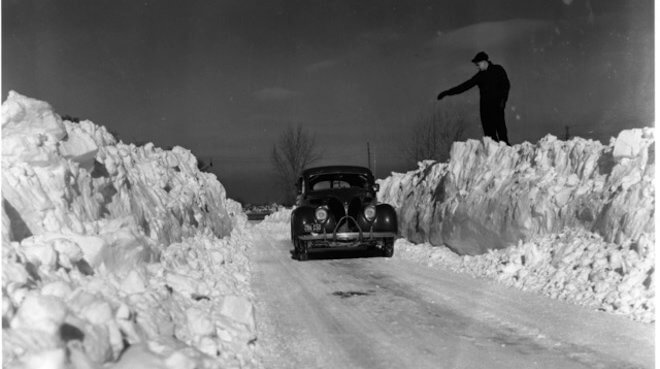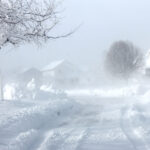
Photo courtesy of Notes on Iowa Facebook Page
Living in Iowa and the rest of the Upper Midwest comes with enjoying or surviving—depending on your perspective—long winters that come with copious amounts of snow.
Yet, some winters come with massive snowstorms that dump several inches of snow and bring high winds that cause blizzard conditions. In fact, the Estherville Vindicator was the first print publication to use the word “blizzard,” from German settlers who called snowstorms blizartig (lightning-like).
Take a look back at some of the biggest snowstorms in Iowa history.
Blizzard of 1923, March 18
The Blizzard of 1923 ended one of the snowiest weeks in Iowa’s history. Some cities in central parts of the state reported up to 30 inches of snow throughout the week. Iowa farmers lost approximately one million young lambs and pigs. The cold exhausted coal supplies and heaps of snow made transportation impossible, so food supplies dwindled in the weeks following the blizzard, causing hardship to many.
[inline-ad id=0]
Armistice Day Blizzard of 1940, Nov. 11
The Armistice Day Blizzard of 1940 not only impacted Iowa, but brought massive amounts of snow and wind to Minnesota, Wisconsin, Illinois, and Michigan, going down in history as one of the biggest snowstorms in the Midwest. Millions of turkeys, other fowl, cattle, and other livestock died during the storm. It dumped up to two feet of snow in areas and winds created 20-foot drifts. Two things set this snowstorm apart for Iowa.
First, there was a drastic drop in temperature throughout the day on Nov. 11. It was in the 40s and 50s in most of Iowa—mild and unsuspecting weather that prevented many from realizing what was coming their way. The severe weather that erupted even led to a tornado near Davenport. Second, the Armistice Day Blizzard of 1940 destroyed Iowa’s status as a major fruit-growing state. The storm destroyed all the apple orchards, most of which were near Winterset. Farmers replanted with crops like soybeans and corn instead of expensive apple trees.
[inline-ad id=”2″]
New Year’s Day Blizzard 1942, Jan. 1
Another major snowstorm in Iowa’s history occurred on New Year’s Day in 1942. A giant storm made its way across the country, dumping ample amounts of white stuff in Iowa and throughout the Midwest. In his report, “Outstanding Iowa Storms,” State Climatologist Paul Waite recounted the 1942 blizzard along with other major Iowa snowstorms that occurred before 1970.
During the New Year’s Day Blizzard of 1942, many towns and cities from Page to Black Hawk counties received at least 2 feet of snow. Des Moines saw its heaviest snowfall on record: 19.8 inches. Ames received 24 inches of snow in 24 hours. The extreme cold that blew in after the storm exacerbated the horrible conditions, making them dangerous with temperatures of 20 below and lower.
Blizzard of 1951, March 9-17
The Blizzard of 1951 holds a special place for Iowans because of its length. This slow-moving storm lasted for between 90 and 100 hours depending on the location. Total snowfall accumulations were off the charts, with Iowa City receiving the highest amount of snowfall for the state through history: 27.2 inches. The city received 21 inches in just two days. Other areas of the state reported between 13 to 20 inches of new snow. It was the heaviest snowstorm on record in Iowa to this day and the average snowfall across the state was 14.3 inches. Businesses, schools, and roads were closed. Iowans also had to deal with intermittent power and phone outages.
[inline-ad id=”3″]
Blizzard of 1971, Jan. 2-4
The second heaviest snowfall Iowa received came with the Blizzard of 1971. This storm— often referred to as the Great Lakes Blizzard—created huge snow drifts up to 12 feet in some areas. However, Iowa and Nebraska were hit the hardest. The state snowfall average for the Blizzard of 1971 was 10.4 inches. The storm’s heavy winds and subsequent cold led to 13 reported weather-related deaths throughout the state.
Blizzard of 1973, April 8-10
In Iowa, the saying “April showers bring May flowers” sometimes means snow showers. One of the biggest and worst snowstorms in Iowa history occurred in April of 1973. Iowa City, Des Moines, and Cedar Rapids only received a little over a foot of snow. But Belle Plaine and Dubuque received around 20 inches, record snowfall for these cities. Sustained heavy winds gusting upwards of 65 mph created massive snow drifts of up to 16 feet and poor visibility that closed down most of Iowa’s roads until the storm passed.
Blizzard of 2009, Dec. 8
The Blizzard of 2009 almost shattered the previous record from 1951 in terms of average snowfall across the state. Iowans had been warned of the storm; the entire state was under a blizzard warning but many weren’t prepared for the storm that was about to come. Iowans saw between 8 and 17 inches depending on where they lived. The storm also brought high winds and huge snow drifts that covered cars. The temperature stayed near 10 degrees, but the high winds created wind chills as low as 30 degrees below zero in some areas.
By Jessica Lee
12/15/22
[inline-ad id=”0″]
If you enjoy stories like these, make sure to sign up for Iowa Starting Line’s main newsletter and/or our working class-focused Worker’s Almanac newsletter.
Iowa Starting Line is part of an independent news network and focuses on how state and national decisions impact Iowans’ daily lives. We rely on your financial support to keep our stories free for all to read. You can contribute to us here. Also follow us on Facebook and Twitter.
Politics

Biden cancels student loan debt for 2,690 more Iowans
The Biden administration on Friday announced its cancellation of an additional $7.4 billion in student debt for 277,000 borrowers, including 2,690...

The Republican war on Medicare raises the stakes in 2024
Nearly 670,000 Iowans rely on Medicare benefits—benefits they spent decades paying into, with the promise that the program would be there for them...
Local News

No more Kum & Go? New owner Maverik of Utah retiring famous brand
Will Kum & Go have come and gone by next year? One new report claims that's the plan by the store's new owners. The Iowa-based convenience store...

Here’s a recap of the biggest headlines Iowa celebs made In 2023
For these famous Iowans, 2023 was a year of controversy, career highlights, and full-circle moments. Here’s how 2023 went for the following Iowans:...






